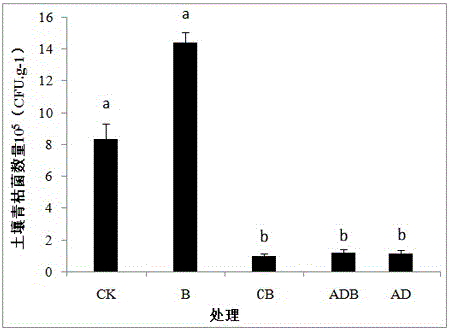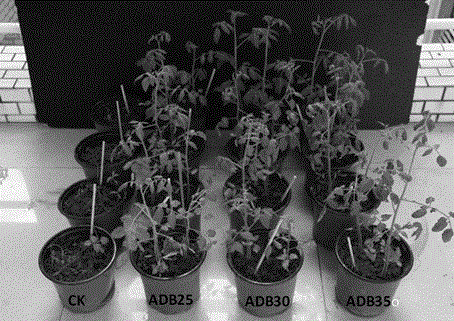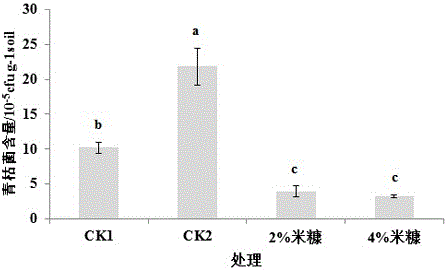Soil anaerobic disinfection method for preventing and controlling tomato bacterial wilt
A technology of tomato bacterial wilt and disinfection method, which is applied in the field of soil anaerobic disinfection method for preventing and controlling tomato bacterial wilt, can solve the problems of environmental damage and human health, damage, etc., and achieve the reduction of the number of bacterial wilt, good control effect, Growth-promoting effect
- Summary
- Abstract
- Description
- Claims
- Application Information
AI Technical Summary
Problems solved by technology
Method used
Image
Examples
Embodiment 1
[0035] 1. Test material
[0036] (1) The test soil was collected from a tomato and rice rotation planting field in Zhucun Town, Zengcheng District, Guangzhou City, Guangdong Province (113.70° east longitude; 23.28° north latitude). This field has a history of tomato bacterial wilt and is slightly acidic. Properties: organic matter content 13.7g kg -1 , total nitrogen content 0.82g·kg -1 , total P content 1.65g·kg -1 , total K content 28.1g·kg -1 , pH=4.66.
[0037] (2) The organic material is rice bran (rice husk), and the diameter of the rice bran is less than 0.2cm.
[0038] (3) The strain of R. solanacearum (R. solanacearum) was selected from physiological race I and biochemical type III, provided by the College of Horticulture, South China Agricultural University.
[0039] 2. Test method
[0040] (1) Preparation of bacterial suspension of R. solanacearum:
[0041] Place R. solanacearum strains stored at room temperature in 2,3,5-triphenyltetrazolium chloride medium,...
Embodiment 2
[0062] 1, carry out embodiment 2 on the basis of embodiment 1, adopt the same test material as embodiment 1, comprise the following steps:
[0063] (1) There are 4 treatments in the experiment, namely:
[0064] Control group (CK);
[0065] Add 2% w / w rice bran at 25°C + water irrigation and cover film to seal anaerobic treatment (ADB25);
[0066] Add 2% w / w rice bran at 30°C + water irrigation and cover film to seal anaerobic treatment (ADB30);
[0067] Add 2% w / w rice bran at 35°C + irrigate and cover film to seal anaerobic treatment (ADB35);
[0068] Each treatment was repeated 4 times.
[0069] (2) Each experimental group weighed 2.0 kg of soil for testing, manually added 20 mL of bacterial suspension, and added 10 mL of bacterial suspension per kg of soil; according to the experimental design, except for the control, the other 3 experimental groups were added with 40.0 g of rice bran, Mix well, transfer to 20×30cm black ziplock bag, place in day / night temperature of 25...
Embodiment 3
[0078] The optimization of embodiment 3 rice bran addition
[0079] 1. The experimental materials are the same as in Example 1.
[0080] 2. Experimental method
[0081] (1) There are 4 treatments in the experiment, namely:
[0082] Control group (CK1);
[0083] Moisturizing treatment (CK2);
[0084] Addition of 2% w / w rice bran + sealed anaerobic treatment (2% rice bran);
[0085] Addition of 4% w / w rice bran + sealed anaerobic treatment (4% rice bran);
[0086] Each treatment was repeated 4 times.
[0087] (2) Each experimental group weighed 2.0kg of soil for testing, manually added 20mL of bacterial suspension, and added 10mL of bacterial suspension per kg of soil; according to the experimental design, except for CK1 and CK2, the other two experimental groups added 40.0g and 80.0g rice bran, mixed well, transferred to 20×30cm black ziplock bags, in which CK2 was kept moist, 2% rice bran and 4% rice bran treatment groups were irrigated to the field water capacity and se...
PUM
| Property | Measurement | Unit |
|---|---|---|
| diameter | aaaaa | aaaaa |
Abstract
Description
Claims
Application Information
 Login to View More
Login to View More - R&D
- Intellectual Property
- Life Sciences
- Materials
- Tech Scout
- Unparalleled Data Quality
- Higher Quality Content
- 60% Fewer Hallucinations
Browse by: Latest US Patents, China's latest patents, Technical Efficacy Thesaurus, Application Domain, Technology Topic, Popular Technical Reports.
© 2025 PatSnap. All rights reserved.Legal|Privacy policy|Modern Slavery Act Transparency Statement|Sitemap|About US| Contact US: help@patsnap.com



